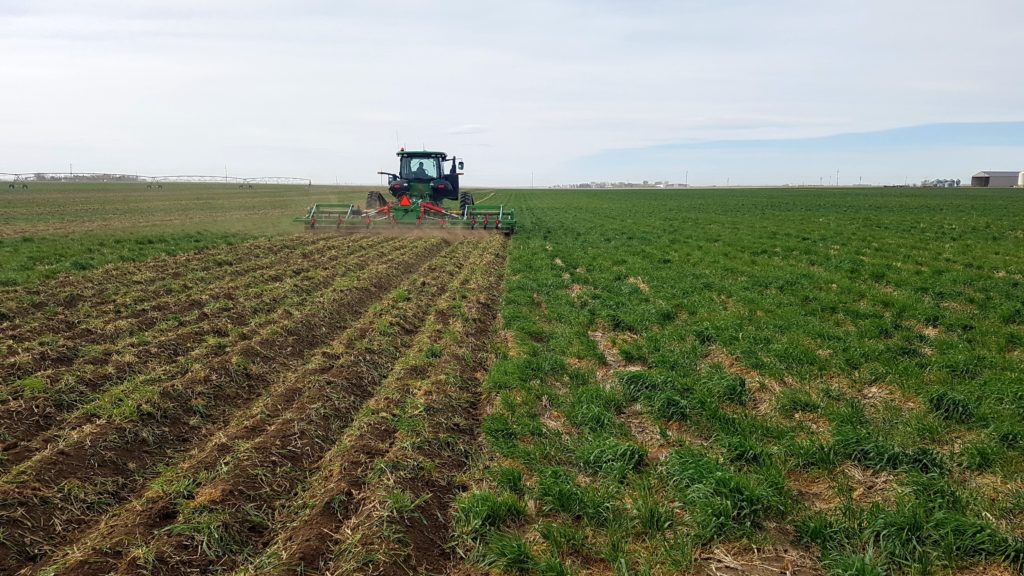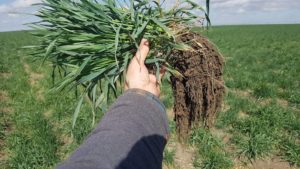
Cover crops and potatoes: How effective are they?
There is nothing new about regenerative agriculture; in fact, it’s as old as farming itself. In recent years, however, it has been pushed into the spotlight and become a buzzword used by food companies that publicly promise to adopt their practices.
One of the cornerstones of the regenerative ag movement is the use of cover crops. But many say cover crops only really work in no-till systems. Removing tillage from potato production is a hard sell, though, and it’s left many potato producers wondering if cover crops are worth the fuss.
Last June, potato processing giant McCain Foods announced a target of advancing regenerative agricultural practices across 100% of its potato acres by 2030. In its global sustainability report, the Canadian-based company said it would like to reduce the amount of carbon dioxide associated with potato farming, storage and transport by 25% by 2030, and improve water use efficiency 15% by 2025 in water-stressed regions.
The company plans to focus on six key principles, including the implementation of cover crops, minimal soil disturbance, enhancing crop diversity, optimizing water use and reducing agro-chemical impact, ensuring farm resilience, and the integration of livestock and organic elements. A good start for most farmers will be the first key principle, the implementation of cover crops.
In a recent webinar, Scott Gillespie, an independent regenerative agriculture consultant with Plants Dig Soil Consulting in Canada, outlined the benefits of adding cover crops to potato production systems.

“Most systems excluded potatoes as an option because the focus is on minimizing or eliminating tillage,” he said. “It makes it hard to try when you’re told that tillage destroys all the work that you’re trying to accomplish.”
But cover crops alone still add benefits. They can reduce the need for herbicides and pesticides while improving yields by enhancing soil health, he said. They can also prevent soil erosion and conserve soil moisture. In the long-term, they help to build soil organic matter and water-holding capacity.
“Organic matter can appear to be building quickly on a soil, but the stable form of it takes many years and takes many cycles of growth and decay,” he said. “This will, in turn, help the total amount of water and nutrients you can hold in your soil.”
“This won’t pay you back directly,” he cautioned. “But if you get the payback in the short- and medium-term benefits, you will build long-term foundations.”
To supercharge the soil, Gillespie suggests growing a green manure crop that can later be chopped and disked into the soil. This method is not possible in all regions, especially those with shorter growing seasons, though. But where they do have a fit, green manure crops like mustard can suppress disease, particularly those in the Early Die complex, he said.
“In the Pacific Northwest of the United States, (farmers) can make this work by doing the green manure after winter wheat harvest, but they have a much longer growing season,” he said. “It’s been proven that you need big biomass to make this work.”
To learn more about how to incorporate mustard in as green manure, Gillespie points to the work of Andy McGuire from Washington State University. “His thinking has influenced how I go about integrating cover crops into potato production,” said Gillespie.
In practice
Already, there are potato farmers making cover crops work. Harold Perry grows Russet Burbank and chipping potatoes on 1,500 acres in Alberta, Canada. He said he started implementing cover crops on his farm 10 years ago, but only really tweaked the system in the last five. Initially, the aim was to provide cover for the soil, as his farm is in a region known for its high winds. He had issues with water-holding capacity and water filtration, as well as with pests and pathogens. Adding a diversity of plants adds diversity in soil biology. he said, which, in turn, makes it healthier and more resilient.
In fall, he plants a mix of winter cereals, including winter wheat, fall rye, Austrian winter pea and oilseed radish. Sometimes he throws in some clover, alfalfa, flax and buckwheat as well, depending on the length of growing season left as they may not establish enough to make soil health benefits. More diverse species starting in September … the shorter the season, the less diverse the mix gets. Have to stick with crops that will grow enough to benefit the soil biology.
“Some of the species we select, their exudates actually suppress some of the pathogens for our potatoes,” said Perry, pointing to potato early die or Verticillium wilt, which are able to enter the plant roots via damage from root lesion nematodes. In the last two years, potato early die has been less of a problem on the farm.
Come spring, Perry uses a power hiller, which rototills the cover crop into the soil, followed by a hill shaper. The system isn’t always perfect, though. “If you have too much trash or too much growth, a power hiller doesn’t work that well and the planters can’t plant into it,” he said, adding that he plants approximately 15-25 pounds of winter seed crops per acre, along with another 30 pounds of annual crops per acre.
Perry adds a word of caution to those who are looking to mixed-species cover crops. “I would select species that don’t host the same diseases or pests that your potatoes do,” he said.
For him, though, cover crops are a no-brainer. They protect his soil from erosion in the short term, and in the long-term, they will help build soil organic matter. “As long as you’re building that, then you’re buffering yourself against future droughts and against plants’ stresses — floods, heat, cold,” he concluded.
In Colorado’s San Luis Valley, potato farmer Brendon Rockey farms on high-mountain desert that sees less than 6 inches of precipitation annually. His soil is sandy, but irrigated. Drought was the driving factor behind his adoption of cover crops, which he first attempted 15 years ago.
“We had depleted the aquifer we were drawing from,” he said, adding that in a two-year rotation, they didn’t have enough water to grow a second cash crop. Rather than leave the land fallow, he decided to add cover crops to help build the soil in the off year. Growing cover crops with 6 inches of annual precipitation wasn’t a problem, he said.
“We saw dramatic water conservation right off the bat,” he said. “After that, we started learning all the other value that came along with them.”
In the early days of adoption, Rockey turned to sorghum sudangrass alone, but three years later he decided to diversify that mix. Today he’s using a 15-16-species mix and companion planting a mix of five legumes and buckwheat with potatoes, as well.
By adding legumes, he’s able to fix nitrogen and add nutrients to the soil, as well as increase carbon cycling while bringing diversity to the root system. Buckwheat helps mobilize phosphate in the soil and feeds beneficial insects.
Rockey said he’s had no equipment issues when companion planting. “Potato equipment is already designed to handle the potato vine at harvest, so having more plants out there, it just gets handled just like the potato vine would,” he said.
When asked if he thought cover crops were a good fit in potatoes, Rockey said he thinks they’re essential.
“It’s allowed us to cut back on our fertility inputs, it’s allowed us to get away from synthetic fertilizers, and we’ve been able to reduce all of our toxic chemical inputs as a result of bringing in this plant diversity and addressing our issues with plants as opposed to chemicals,” he concluded.
Top photo: Harold Perry’s potato field in Alberta, Canada. Photo: Harold Perry







